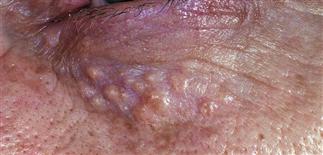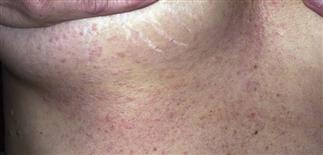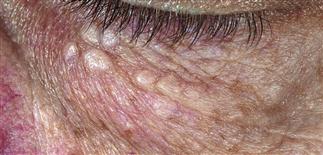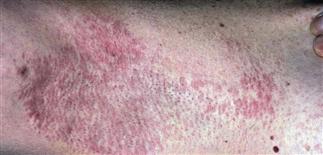125
Syringomas

Syringomas are the most common tumor of the intraepithelial eccrine sweat glands. Appear as asymptomatic flesh-colored papules.

Syringomas occur on the eyelids, malar cheeks, axillae, anterior chest, abdomen, umbilicus, and vulva.

The lower lids are the most common area for finding this appendage tumor. Lesions may be removed with curved scissors to improve appearance.

Papules are usually symmetrically distributed and asymptomatic. May be extensive in Down syndrome and trisomy 21.
DESCRIPTION
Small, firm, skin-colored papules occurring most commonly in women around the eyelids, upper chest, and vulva. Syringomas are the most common tumor of the intraepidermal eccrine sweat glands.
HISTORY
• These appendageal tumors develop after puberty and increase in number throughout young adulthood. • Lesions are asymptomatic, stable in size and appearance, and persistent. • The autosomal dominant inheritance of multiple syringomas is well established. Syringomas occur with increased frequency in individuals with Down syndrome or trisomy 21. • Facial lesions are of cosmetic concern, and most patients request removal of larger lesions. • The patient may be concerned that the lesions are cancerous. • Women seeking evaluation of vulvar lesions may be concerned that the lesions are genital warts.
PHYSICAL FINDINGS
• Small, skin-colored to yellow, 1- to 2-mm, barely raised papules, most commonly found on lower eyelids. They also occur on malar cheeks, axillae, anterior chest, abdomen, umbilicus, and vulva. • Papules usually symmetrically distributed and asymptomatic. • Syringomas persist indefinitely and remain small. They have no potential for malignancy. • They may resemble flat warts or sebaceous hyperplasia.
TREATMENT
• Syringomas may be removed for cosmetic purposes. • Electrodesiccation and curettage, laser surgery, and trichloroacetic acid may be used, with variable success. • Sharp dissection or scissor excision of lesions is easily performed under local anesthesia. • All these procedures can lead to scarring, so care and precision are warranted. • In some patients, syringomas are too numerous to remove all lesions completely.







